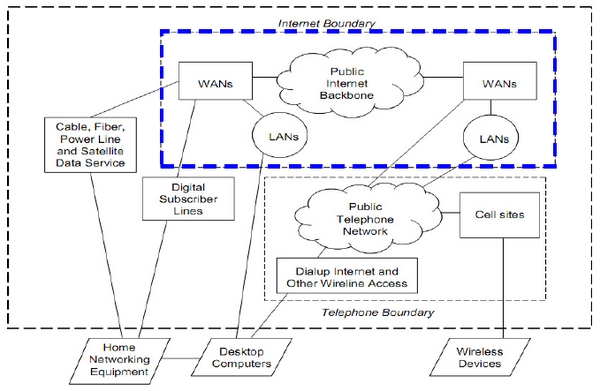
The many enquiries we have received show that other companies are also interested in how to calculate the carbon emissions of internet data transfer.
Below is a description of the method for calculating emissions due to internet data transfer, which AMPEG commissioned another company to develop especially for its carbon neutrality project.
Methodology to calculate emissions of internet data transfer
As AMPEG operates in the IT sector, its work results in considerable volumes of internet data transfer. This data transfer causes emissions that are not under AMPEG’s control and should be conservatively accounted for in the calculation.
Figure 1 shows an example of the system boundaries in internet use. All emissions that are caused by the electricity consumed by AMPEG’s hardware (e.g. computers, servers, switches, routers) have already been included in the calculations of emissions caused by energy usage.
The “internet boundary” is the relevant one for calculating the emission levels of AMPEG’s data flows. The energy intensity of data transfer is calculated by Taylor and Koomey (2008)1 to lie between 9-16 kWh/GB. This data is based on American statistics from 2006. The energy intensity for data transfer has decreased substantially since then. Between 2000 and 2006 the specific energy intensity decreased by a factor of 10. A report by McAfee from 2009 assumes a specific energy intensity of 5.8kWh/GB.2 Another report from 2009 on emissions caused by downloading music3 uses Taylor and Koomey’s data basis but also takes account of internet developments since 2006. This study uses a range of 5-9 kWh/GB. The maximum figure of this study was used to calculate the emissions at AMPEG as this is the most recent study. The maximum figure was chosen to ensure a conservative result. The German electricity mix was used to define the emission factor.
The equation for calculating the carbon emissions of internet data transfer is thus as follows:
Volume of incoming and outgoing internet data transfer in GB x 9 kWh/GB x g(CO2)/kWh of the German electricity mix
Companies can obtain the precise data on the volume of their incoming and outgoing internet data transfer from their internet provider. The emission factor of the German electricity mix is published by the Federal Environment Agency at http://www.umweltbundesamt.de/themen/klima-energie/energieversorgung/strom-waermeversorgung-in-zahlen (direct link to the report [in German]: CO2-Strommix).
As the electricity consumption per GB of internet data transfer has hopefully decreased further, AMPEG will commission a new study on which to base its calculations for achieving carbon neutrality in 2011.
1 Estimating Energy Use and Greenhouse Gas Emissions of Internet Advertising, Cody Taylor and Jonathan Koomey, 14 February 2008
2 McAffee: The Carbon Footprint of Email Spam Report, ICF International, 2009
3 THE ENERGY AND CLIMATE CHANGE IMPACTS OF DIFFERENT MUSIC DELIVERY METHODS Christopher L. Weber, Jonathan G. Koomey, and H. Scott Matthews, 17 August 2009

